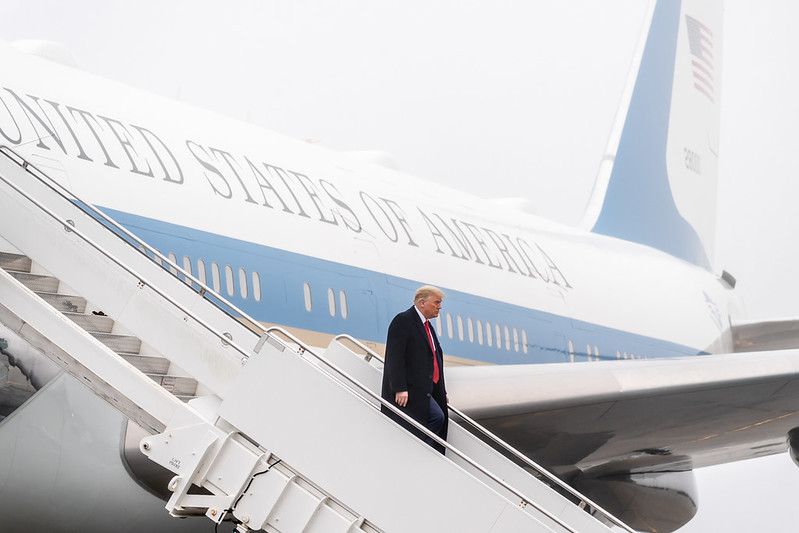Twitter is the (Very Short Term) Winner of the Trump Oversight Board Saga
Twitter’s ban of Trump marked the defining moment of the Great Deplatforming. But all the attention surrounding the FOB decision has precipitated a dramatic reversal of fortune.

Published by The Lawfare Institute
in Cooperation With

On June 4, Facebook responded to the Facebook Oversight Board’s (FOB) decision about the fate of former President Trump’s Facebook account, booting Trump from the platform for two years and offering up a collection of responses to the Oversight Board’s nonbinding policy recommendations. People parsed through the 20-page response document and came out in different places. Some writers characterized Facebook’s response as something of a win for Trump, who could—if he behaves—make his way back on the platform before the 2024 presidential election cycle. Others argued the responses mark a victory for the Oversight Board—though not everyone is so convinced.
But the real near-term winner of the whole FOB-Trump ordeal is neither Facebook nor the Oversight Board nor Trump. It’s Twitter.
Trump’s social media accounts met their demise during a 48-hour “Great Deplatforming” in the aftermath of the Jan. 6 insurrection. Facebook, Snapchat and YouTube all froze Trump’s accounts; Reddit, Stripe, Shopify and even Peloton purged Trump-linked activity. But Twitter’s permanent ban of Trump towered above the rest and marked the defining moment of the sweep. @RealDonaldTrump served as the avatar of and mouthpiece for Trump’s presidency, his singular vehicle for expressing the powers of the office. And Twitter disappeared the president’s public persona with a single technocratic Friday night blog post on Jan. 8, becoming the main target for public criticisms of Trump’s broader “deplatforming”: Fox News took aim at the “extraordinary step” Twitter took in “censor[ing]” Trump; German Chancellor Angela Merkel singled out Twitter’s Trump ban as “problematic.” Facebook’s then-temporary suspension of Trump comparatively flew under the radar.
But all the hullabaloo surrounding the FOB decision and Facebook’s response has precipitated a dramatic reversal of fortune. Facebook’s decision to submit the Trump decision to the Oversight Board process opened the door for a five-month public referendum over Facebook’s handling of Trump’s account. Unrelenting tweeting, push alerts and a stream of denunciations from Republican politicians all funneled attention to Facebook’s Trump decision and created something of a false public memory that the Facebook ban was the big deal in the first place. The attention to Facebook came with some upside—particularly for the FOB, which got to flex its limited power in a hyper public context—but it also meant that reporters lingered on granular details of Facebook’s handling of Trump, while other platforms that took an even harsher tact with Trump got to duck this round of attention.
Twitter, which has no review system like the Oversight Board, has long turned the page on Trump and now devotes its platform governance battles to more important problems. In this sense, the whiplash inspired by the Oversight Board’s Trump decision underscores the short-term drawbacks of imposing a formal structure to relitigate moderation decisions. But as Twitter flies into other high-stakes spats with heads of state, its lack of a post hoc review system may well be a long-term loser in the battle for platform governance legitimacy.
Twitter tore off the Trump bandaid over the course of a couple days. I described Twitter’s process at the time:
The permanent ban followed a 48-hour tug-of-war between Trump and the platform. In the aftermath of the riot—which itself began after he told the would-be rioters “we’re going to walk down to the Capitol … you’ll never take back our country with weakness”—Trump used the platform to post a video addressing his fans in the Capitol: “Go home, we love you. You’re very special.” Twitter responded by preventing anyone from replying to, liking or retweeting the video. The platform later removed three of Trump’s tweets and locked @realdonaldtrump for 12 hours. And then it banned him for good.
Swift internal deliberations—with Twitter CEO Jack Dorsey calling in from vacation in French Polynesia—hastened the demise of Trump’s account. And the final blow came in the form of a 650-word blog post explaining that Trump violated Twitter’s glorification of violence policy and pronouncing his permanent suspension from the platform. The post noted that Twitter has special considerations for review of world leaders accounts, then calmly walked through the ways in which two relatively benign Trump tweets (the final straw: “To all of those who have asked, I will not be going to the Inauguration on January 20th.”) crossed the line. The company’s last word on the Trump ban came a week later, when Dorsey wrote an anguished Twitter thread explaining that “I do not celebrate or feel pride in our having to ban @realDonaldTrump from Twitter,” but that “I believe this was the right decision for Twitter. We faced an extraordinary and untenable circumstance, forcing us to focus all of our actions on public safety.” Twitter has no secondary review body to make post hoc judgments about whether its moderation decisions pass muster, so the conversation about Twitter’s Trump ban has steadily tapered from there.
For Facebook, Trump’s “indefinitely suspend[ed]” account has been a zombie that has slogged its way through the news cycle for five months after the original suspension—and will re-emerge again in 2023. Facebook first took action against Trump’s account on Jan. 6 at 5:41 p.m. EST, removing Trump’s notorious “We love you. You’re very special” video for violation of the platform’s Community Standard on Dangerous Organizations and Individuals. Twenty-six minutes later, Trump posted to Facebook: “These are the things and events that happen when a sacred landslide election victory is so unceremoniously viciously stripped away from great patriots who have been badly unfairly treated for so long. Go home with love in peace. Remember This day forever!” This got him a 24-hour ban from Facebook. The next day, using vague language that would later earn it a reprimand from the FOB, Facebook banned Trump “indefinitely.” A Mark Zuckerberg Facebook post explained that Trump would be locked out of his Facebook and Instagram accounts “for at least the next two weeks until the peaceful transition of power is complete.”
But the “indefinite ban” was just the first of four different news cycles around Facebook’s Trump ban. Two weeks after the Zuckerberg post, and one day after Inauguration Day, Facebook announced it had referred the Trump suspension to the Oversight Board for review (making it, at the time, only the third dispute that the FOB took up by way of Facebook referral). And with the announcement, Facebook’s Trump suspension filtered back into the platform governance news cycle; Ben Smith of the New York Times, for example, wrote a piece a few days later (with the headline “Trump Wants Back on Facebook. This Star-Studded Jury Might Let Him.”) that characterized the fate of Trump’s Facebook account as an issue of global political significance—and he wasn’t necessarily wrong. The Oversight Board referral meant that Facebook’s Trump suspension became the open test case for free speech and geopolitical anxiety about “deplatforming” world leaders; Twitter’s opting for unreviewable finality meant that it got to duck many of these conversations, at least as they pertain to Trump. (Youtube, which has put Trump’s account on ice while an “elevated violence risk still remains,” whatever that means, has also managed to stay out of the limelight here.)
The Facebook-Trump news trickle swelled to a tidal wave of push alerts with the Oversight Board decision on May 5. U.S. cable news anchors devoted prime time slots to anticipating and reacting to the decision, with one host ruminating: “To tell you the truth, the whole thing seems like something out of a science fiction novel. We’re sitting here tonight wondering if the advisory board of the one of [sic.] most powerful corporations on earth will allow the former president to once again post his inflammatory nonsense. ” The Twitter accounts of politics and tech reporters devolved into a continuous stream of reactions to the 23-page decision. Four months removed from the Great Deplatforming, with an entirely new U.S. president long installed in the Oval Office, the news cycle was stuck on Facebook’s handling of Trump’s account. Facebook had 30 days to respond to the Oversight Board’s decision, and its June 4 response revamped the Trump Facebook account news cycle once more, albeit to a lower decibel level.
The whole Oversight Board review process hogged so much attention that it just might have warped public memory of the slate of early January Trump bans. It siphoned attention away from Twitter’s permanent ban and pulled it toward Facebook’s “indefinite” suspension. The FOB isn’t a court (far from it). But much in the way that a high-profile court case can inflect popular understanding of the underlying event being litigated, the Oversight Board review process created something of an erroneous third-person memory about the relative importance of different platform’s handling of Trump’s accounts. Twitter’s public policy team surely delights in the fact that many people now associate “Trump ban” with Facebook, not Twitter—and that the protracted six-month news cycle around the Oversight Board decision deflected some attention from the unceremonious Friday night massacre by which Twitter deleted a sitting U.S. president’s public presence.
The whole Oversight Board process also, by design, served to introduce doubt about the propriety of Facebook’s handling of Trump’s account. The FOB has the mandate to scrutinize Facebook’s moderation decisions and architecture; and following the FOB’s Trump decision entails for the public—consciously or not—assuming some of that perspective and looking at Facebook’s Trump suspension with the eye of a skeptical reviewer.
One way to think about the difference between how Facebook and Twitter handled Trump’s account is that the two models just represent two different ways to give legalistic window-dressing to what are, at bottom, public relations decisions. Evelyn Douek wrote at the time of the Great Deplatforming about the “formalist myth” of moderation that “platforms want us to believe,” whereby moderation decisions are “based on … neutral, carefully considered evaluations of the rules and the facts.” One way to foster the appearance of rule-bound formalism is to remove a sitting U.S. president with a dry blog post that purports to adhere to strict Terms of Service textualism; another way is to stand up a $130 million review body and staff it with law professors. If the difference between the Facebook process and Twitter process just came down to two different architectures for each platform’s chosen “giant P.R. Potemkin village,” Twitter’s short-term escape from scrutiny has less of a long-term downside.
But the FOB process did show that the board had some bite. It dredged up information about how exactly Facebook handled Trump’s account. It excavated some unseemly details about Facebook’s process for handling high-profile accounts. It forced Facebook to clean up and clarify its “strikes” process and to at least nominally remove the “newsworthiness” exemption it accorded to politicians. These all have enduring benefits that extend far beyond Trump, and they make any short-term PR hit for Facebook a worthwhile sacrifice in the road to long-term legitimacy. (This is in addition to all the other work the FOB does, most of which concerns activity in countries not called the United States and none of which comes close to getting the attention that the Trump decision got.)
The FOB process may have saved Twitter from prolonged headlines this time around, but scrutiny will only build as Twitter plunges into more and more messy fights with heads of state around the world. On May 19, for example, Twitter applied its “manipulated media” label to tweets from members of India’s ruling Bharatiya Janata Party, earning it a letter from the Narendra Modi government that explicitly asked the platform to remove the tags and, later, visit at its India office from an elite counterterrorism police unit to hand-deliver a note expressing the government’s ire with Twitter’s refusal to pull the labels. Two weeks later, it deleted a tweet from the president of Nigeria and got banned from the entire country in return. Twitter deserves praise for taking a stand against governments to which other platforms have capitulated, but it does need to more clearly explain the framework in which it makes these decisions—regardless of whether or not that comes at the prompting of an eventual FOB lookalike.





